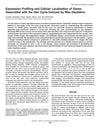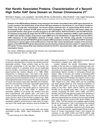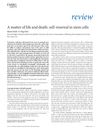TLDR Runx1 helps control the KAP5 gene in human hair follicles.
The study investigated the role of the Runx1 transcription factor in regulating the expression of the KAP5 gene in human hair follicles. Keratin-associated proteins (KAPs), particularly the ultrahigh sulfur KAP5 subfamily, are crucial components of hair fibers. The research focused on the expression of Runx1 in human hair follicles using immunohistochemical methods and examined its effect on KAP5.1 gene expression through overexpression studies in cell cultures. The findings suggested that Runx1 plays a significant role in the regulation of KAP5 gene expression, which is predominantly expressed in the cuticle layer of anagen hair follicles.
 27 citations
,
August 2005 in “The journal of investigative dermatology/Journal of investigative dermatology”
27 citations
,
August 2005 in “The journal of investigative dermatology/Journal of investigative dermatology” Researchers found new genes involved in hair growth, which could help develop new hair treatments.
34 citations
,
June 2005 in “Developmental dynamics” Runx3 helps determine hair shape.
6 citations
,
April 2005 in “Journal of dermatological science” The study found nine new hair protein genes in human hair follicles.
27 citations
,
April 2004 in “Biochemical and Biophysical Research Communications” Two new gene clusters important for hair formation were found on human chromosome 11.
 62 citations
,
January 2004 in “The journal of investigative dermatology/Journal of investigative dermatology”
62 citations
,
January 2004 in “The journal of investigative dermatology/Journal of investigative dermatology” A second domain of high sulfur KAP genes on chromosome 21q23 is crucial for hair structure.
46 citations
,
August 2006 in “Mechanisms of Development” Runx1 is crucial for proper hair structure and development.
63 citations
,
November 2012 in “Journal of Cellular Biochemistry” Runx1 affects hair growth, cancer development, and autoimmune diseases in epithelial tissues.
 24 citations
,
July 2018 in “Stem cells”
24 citations
,
July 2018 in “Stem cells” Runx1 controls fat-related genes important for normal and cancer cell growth, affecting skin and hair cell behavior.
August 2013 in “eCommons (Cornell University)” Runx1 and CDK inhibitors help keep hair follicle stem cells inactive, affecting their future roles.
 150 citations
,
December 2012 in “EMBO Reports”
150 citations
,
December 2012 in “EMBO Reports” Stem cell self-renewal is complex and needs more research for full understanding.



